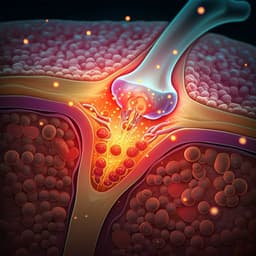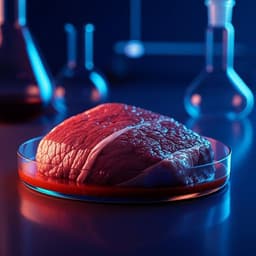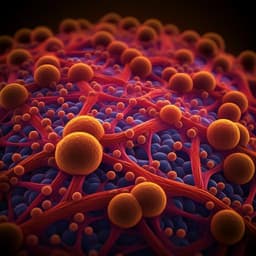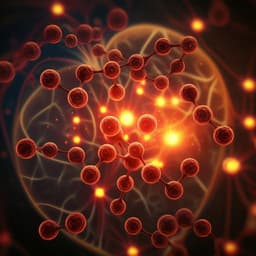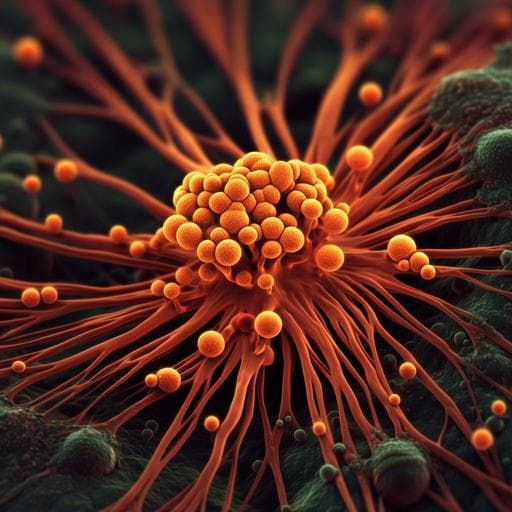
Food Science and Technology
Fungus-derived protein particles as cell-adhesive matrices for cell-cultivated food
Y. X. Teo, K. Y. Lee, et al.
Discover how a team of researchers, including Yu Xing Teo and Kah Yin Lee, is pioneering a sustainable future for cell-cultivated food by exploring fungus-derived proteins as an alternative to conventional animal-derived cell-adhesive factors. Their innovative work with basidiomycete fungi reveals a groundbreaking approach for effective cell adhesion and alignment.
~3 min • Beginner • English
Introduction
Cell-adhesive materials that support attachment, spreading, proliferation, and differentiation are essential in biomedical and pharmaceutical applications, notably tissue engineering where scaffolds must facilitate adhesion of diverse mammalian cell types. Conventional adhesion relies on animal-derived ECM proteins (e.g., collagen, fibronectin) that are biocompatible and present native ligands. Sustainability and animal welfare concerns have driven interest in cell-cultivated products (meat, milk, liver), where many anchorage-dependent cells (e.g., muscle) require adhesive culture supports. Ideally, supports should be non-animal-derived and edible so they can be incorporated into the final food product. A rational route to non-animal alternatives is to search for proteins bearing the Arg-Gly-Asp (RGD) motif, a well-established cell-adhesive sequence. While a few RGD-containing plant proteins have been reported (e.g., in cardoon), RGD-containing proteins are more richly documented across fungi, including pathogenic species. This study investigates the prevalence of RGD motifs across fungi and plants via data mining, and develops a simple extraction/precipitation method to produce fungus-derived protein particles as ECM-like matrices to support mammalian cell adhesion and function in 2D and 3D culture, targeting sustainable applications in cell-cultivated foods and healthcare.
Literature Review
The RGD motif is a classic integrin-binding sequence mediating cell adhesion and downstream regulation of proliferation and differentiation. Prior reports document only limited RGD-containing plant proteins (e.g., cardosin A/cardoon-derived proteins), whereas fungal literature indicates broader distribution of RGD-bearing proteins, especially in pathogenic species where RGD-mediated interactions with host integrin-like receptors can modulate plant defense responses. Animal ECMs like collagen, fibronectin, laminin, and composite materials like Matrigel are widely used but pose sustainability issues. Plant-based scaffolds (e.g., decellularized plant tissues, textured soy protein) need cell-adhesive factors; to date, these have mainly been animal ECMs or synthetic/recombinant peptides. The study positions fungi-derived proteins as a sustainable, edible alternative source of cell-adhesive factors.
Methodology
RGD data mining: The authors screened for RGD-containing proteins across fungi and plants using RefSeq (fungi) and GenBank (GBPLN, Fungi, Plantae). Data were downloaded via FTP on 2021/07/15 and 2021/08/16. Redundant proteins (same protein name within the same organism) and organisms with fewer than the average number of protein sequences were filtered out to avoid inflated RGD percentages. A custom Python script identified the “RGD” motif in protein sequences and computed RGD% = (proteins containing RGD / total proteins) × 100 for each species.
Extraction and particulate CAF preparation: Edible mushrooms (Flammulina velutipes, Grifola frondosa, Lentinus edodes, Pleurotus eryngii, Pleurotus ostreatus) were purchased retail. Fungi were frozen in liquid nitrogen and blended to powder. A typical preparation used 14 g powder in 25 mL deionized water, shaken to homogeneity, sonicated on ice (30 min, 10% amplitude) to disrupt cells (crude extract), and centrifuged (10,000 rpm, 4 °C, 10 min) to pellet insoluble biomass. The supernatant was heated on a hotplate at 200 °C for 20 min, forming a white precipitate. After cooling, the mixture was centrifuged (10,000 rpm, 10 min), the pellet resuspended in 10 mL deionized water, washed by another centrifugation, and collected as cell-adhesive factors (CAFs; particulate extract).
Precipitation/aggregation analysis: Dynamic light scattering (DLS) measured particle sizes from crude extracts prepared at 3.5, 7, and 14 g fungal powder in 0.01 M Tris, 5 mM MgCl2 buffer at 4 °C, across temperatures 60, 70, 80, and 90 °C. For each organism, 36 DLS runs covered 12 combinations of concentration and temperature (in triplicate). A particle aggregation model was developed (Supplementary Information).
3D cell encapsulation and alignment assay: C2C12 mouse myoblasts were encapsulated within interfacial polyelectrolyte complex fibers formed from water-soluble chitin and sodium alginate, with incorporation of fungal particulate extracts (FV: F. velutipes; LE: L. edodes; PE: P. eryngii), collagen (control), or no ECM. Fibers were formed by contacting droplets of 1% alginate containing 2% CAFs with water-soluble chitin and drawing fibers, which were mounted on nitrocellulose frames and cultured in DMEM + 10% FBS. Cell alignment along fibers was imaged over 0, 1, 2, and 4 days, and quantified using ImageJ and MATLAB to compute orientation distributions and frequencies at 0°/180° and 90°.
Traction force microscopy (TFM): Polyacrylamide hydrogels (14 kPa Young’s modulus) with embedded 0.2 µm red fluorescent beads were functionalized with fibronectin (50 µg/mL) or F. velutipes particulate extract (FVP) at 0.1%, 1%, 5%, 10% (v/v in PBS). Negative controls included sterile water (no ECM) and integrin-blocking with GRGDS peptide (2 mg/mL, 90 min preincubation) before seeding. C2C12 cells were seeded (50,000 cells/coverslip, 24 h). Bead images were acquired before and after cell detachment (TrypLE), and displacement fields calculated via digital image correlation to estimate traction stress fields (inverse Boussinesq solution). Imaging used a Leica Stellaris 8 confocal microscope; analysis employed established TFM pipelines.
Proteomics (SDS-PAGE and MS/MS): Extracts (combined crude and particulate) were processed for whole-sample proteomics and for gel-excised bands. Samples were reduced/alkylated (TCEP/CAA), digested (LysC then trypsin), desalted, and analyzed by LC–MS/MS (Orbitrap Fusion for whole samples; Q Exactive HFX for SDS-PAGE fractions). Database searches (Proteome Discoverer v2.4) used UniProt TrEMBL protein sets for F. velutipes, L. edodes, P. eryngii with fixed carbamidomethylation (Cys) and dynamic deamidation (Asn, Gln), N-terminal acetylation, and Met oxidation; trypsin/P with up to 3 missed cleavages; 10 ppm precursor and 0.8 Da fragment tolerances; FDR 1% (strict)/5% (relaxed). Identified proteins were cross-referenced to RGD-containing sequences via the data mining protocol. SDS-PAGE (with molecular weight ladder) profiles were mapped with candidate RGD proteins based on measured MW/pI and Mascot identifications.
Key Findings
- Data mining across GenBank/RefSeq identified 352,056 RGD-containing proteins among 6,346,526 total proteins (~5.5%). Approximately 98% of fungal and plant species had RGD% ≥ 1%, and ~8.8% had RGD% > 5%. Several parasitic fungi (Aspergillus fumigatus, Ganoderma lucidum, Cryptococcus neoformans, Cordyceps militaris) showed the highest RGD% (8–10%), while edible fungi (Lentinus edodes, Flammulina velutipes, Pleurotus eryngii) exhibited RGD% between 2–8%.
- Fungal crude extracts from basidiomycetes spontaneously formed white protein precipitates at room temperature, accelerated by heating/boiling. Particle diameters ranged from ~146–1831 nm, with precipitation/aggregation propensity P. eryngii > F. velutipes > L. edodes, independent of crude protein concentration (L. edodes had highest protein concentration yet slowest precipitation).
- 3D fiber encapsulation showed that C2C12 myoblasts aligned along fiber axes across all conditions. Fibers containing fungal particulate extracts (FV, LE, PE) or collagen exhibited significantly higher fractions of cells/aggregates oriented at 0°/180° compared to no-ECM fibers, indicating enhanced cell–matrix adhesion (n ≥ 12 for alignment plots; n ≥ 3 for orientation frequency; statistical significance via chi-square tests).
- Traction force microscopy on 14 kPa hydrogels demonstrated that C2C12 cells on FVP-coated substrates generated traction stresses comparable to fibronectin-coated substrates. Increasing FVP concentration increased cell spread area and maximum traction stress, with saturation at 10% FVP: 0.1% FVP ~214 Pa vs 10% FVP ~599 Pa maximum traction stress per cell (N ≥ 14 cells). No adhesion/traction was observed on no-ECM surfaces. GRGDS peptide blocked adhesion and traction on both fibronectin- and FVP-coated substrates, confirming RGD-mediated integrin involvement.
- Proteomics (SDS-PAGE/MS) identified likely RGD-containing proteins in extracts: for F. velutipes, a ~30 kDa C1 protein (inositol pyrophosphate synthase; UniProt O74163) and ~99.6 kDa beta-glucosidase (G8A544) were prominent; for P. eryngii, a ~30 kDa Zb protein (Q7ZA62; identical sequence to F. velutipes C1) and aryl-alcohol oxidase (~63.7 kDa; O94219/D3YBH4) were detected; for L. edodes, nucleoside diphosphate kinase (~20–30 kDa; A0A1Q3EJT6) was identified. The F. velutipes C1 protein mapped to a major SDS-PAGE band, supporting its role in adhesion. Homology modeling suggested surface-exposed RGD motifs for most candidates.
- Overall, edible fungi provide a sustainable, scalable source of cell-adhesive protein particles that retain RGD-mediated adhesion, suitable for integration into edible scaffolds for cell-cultivated foods and as animal-free ECM alternatives in healthcare.
Discussion
The findings demonstrate that RGD-bearing proteins are pervasive across fungi and plants, revealing a largely untapped reservoir of non-animal cell-adhesive factors. By focusing on edible basidiomycetes with relatively high RGD percentages, the study establishes a simple, low-cost route—extraction followed by heat-induced denaturation/aggregation—to produce submicron protein particles that function as ECM-like matrices. Denaturation preserves the primary RGD motif while likely inactivating enzymatic activity, minimizing unintended bioactivity on mammalian cells. Functionally, the fungal particulate extracts promote cell–matrix interactions, evidenced by enhanced alignment in 3D fibers and traction stresses comparable to fibronectin in 2D TFM, with RGD-integrin dependence confirmed via GRGDS inhibition. Proteomics supports the presence of specific RGD-containing proteins (e.g., C1/Zb protein) in these particles, though compositions are mixed and can include non-RGD proteins that may contribute structurally or via other adhesive motifs. The approach offers a sustainable alternative to animal ECMs and composite matrices like Matrigel, aligning with the goals of cell-cultivated food production where edible, non-animal adhesive matrices are preferred. Beyond food, these insoluble protein particles could be incorporated into tissue engineering scaffolds as more sustainable biomaterials. The ubiquity of RGD across fungi suggests broad species availability, enabling streamlined candidate selection via RGD% screening and subsequent particle production.
Conclusion
This work introduces a data-driven pipeline to identify fungi rich in RGD-containing proteins and a straightforward extraction/heat-precipitation process to generate protein particles that function as cell-adhesive matrices. These fungus-derived ECM-like particles support mammalian cell adhesion and alignment in 3D and generate traction forces comparable to fibronectin in 2D, with adhesion mediated by RGD-integrin interactions. Proteomic analyses highlight likely RGD-bearing proteins (e.g., C1/Zb protein) in edible fungi extracts. The approach provides a sustainable, scalable, and potentially edible alternative to animal-derived ECM for cell-cultivated foods, with additional relevance to healthcare scaffolds. Future research should comprehensively map the protein composition across more fungi, delineate the contributions of non-RGD motifs, optimize particle formulation and dosing for different cell types, and evaluate performance in diverse edible scaffold systems and bioprocess conditions.
Limitations
- Protein composition was only partially characterized; full identification of all proteins in the particulate extracts was beyond the study’s scope.
- Many fungal proteomes are incompletely curated; database searches relied on UniProt TrEMBL (computationally inferred sequences), which can include redundancies or annotation uncertainties.
- For Pleurotus eryngii and Lentinus edodes, RGD-containing proteins detected by MS did not map to major SDS-PAGE bands, suggesting possible involvement of lower-abundance proteins or additional adhesive motifs beyond RGD.
- Data mining filtered organisms with few reported proteins to stabilize RGD% estimates, potentially excluding rare species with limited sequence data; RGD% reflects available database coverage rather than absolute proteome content.
Related Publications
Explore these studies to deepen your understanding of the subject.



